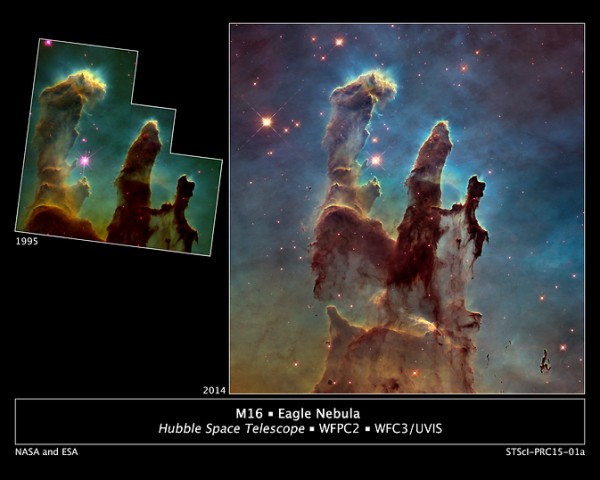Happy 25th Birthday Hubble Space Telescope! Here's Hubble's Most Iconic Photo
| Ana Verayo | | Apr 13, 2015 08:46 AM EDT |
(Photo : NASA/ESA/Hubble Heritage Team (STScI/AURA)/J. Hester, P. Scowen (Arizona State U.)) Astronomers using NASA's Hubble Space Telescope have assembled a bigger and sharper photograph of the iconic Eagle Nebula's "Pillars of Creation" (right). The original 1995 Hubble image is shown at left.
This month celebrates the 25th anniversary of the Hubble Space Telescope whose discoveries have revolutionized the field of astrophysics and revealed the Universe with never before seen amazing views.
Hubble was built by NASA with contributions from the European Space Agency. The space telescope uses a 2.4 meter primary mirror as its eye as it orbits around Earth 340 miles above the surface. The telescope is also traveling at a speed of 17,500 miles per hour and its already covered a distance comparable to a trip to Neptune.
Like Us on Facebook
Named after American astronomer, Edwin Hubble, who used a 2.5 meter telescope on top of Mount Wilson in California to make observations of distant galaxies. Hubble's findings showed the Universe was ever expanding and led to the Big Bang model that explains the origins of the Universe.
To date, the telescope has made over one million observations from a remarkable distance of 13.4 billion light years.
The first images Hubble sent back to Earth were disappointing since the main mirror had suffered from a spherical aberration that caused significant blurring in all images taken. In 1993, NASA astronauts repaired the telescope with corrective optics and Hubble was now able to capture spectacular images of the Universe.
One of these images is the "Pillars of Creation" considered Hubble's most iconic image. This spectacular photo involves three massive pillars of cold gas bathed in UV light from a cluster of stars found in the Eagle Nebula.
The construction and operations of the space telescope reached US$10 billion. Scientists and astronomers achieved so much more from the telescope as it made breathtaking discoveries of infant and dying stars and nebulae, of complex spiral galaxies similar to the Milky Way and even irregular ones created by stellar mergers.
Among Hubble's most notable discoveries is a rare comet impact in 1994 where it took photos of huge debris lumes from Comet Shoemaker-Levy 9 after it smashed into Jupiter. It also detected sodium, carbon and oxygen gases in alien worlds thousands of light years away.
Hubble also shed light on quasars that are highly luminous distant objects in the universe powered by supermassive black holes. This also led to the theory of dark matter and dark energy in 1998.
The space telescope also helped identify the Universe's age, which is now known to be 13.8 billion years old or three times the age of Earth.
Hubble's successor is slated to be the James Webb Space Telescope that is now under construction and will be launched in 2018.
TagsHappy 25th Birthday Hubble Space Telescope! Here's Hubble's Most Iconic Photo, NASA, ESA, Hubble Space Telescope, 25 anniversary hubble space telescope, most iconic hubble image, hubble photos
©2015 Chinatopix All rights reserved. Do not reproduce without permission
EDITOR'S PICKS
-

Did the Trump administration just announce plans for a trade war with ‘hostile’ China and Russia?
-

US Senate passes Taiwan travel bill slammed by China
-

As Yan Sihong’s family grieves, here are other Chinese students who went missing abroad. Some have never been found
-

Beijing blasts Western critics who ‘smear China’ with the term sharp power
-

China Envoy Seeks to Defuse Tensions With U.S. as a Trade War Brews
-

Singapore's Deputy PM Provides Bitcoin Vote of Confidence Amid China's Blanket Bans
-

China warns investors over risks in overseas virtual currency trading
-

Chinese government most trustworthy: survey
-

Kashima Antlers On Course For Back-To-Back Titles
MOST POPULAR
LATEST NEWS
Zhou Yongkang: China's Former Security Chief Sentenced to Life in Prison

China's former Chief of the Ministry of Public Security, Zhou Yongkang, has been given a life sentence after he was found guilty of abusing his office, bribery and deliberately ... Full Article
TRENDING STORY

China Pork Prices Expected to Stabilize As The Supplies Recover

Elephone P9000 Smartphone is now on Sale on Amazon India

There's a Big Chance Cliffhangers Won't Still Be Resolved When Grey's Anatomy Season 13 Returns

Supreme Court Ruled on Samsung vs Apple Dispute for Patent Infringement

Microsoft Surface Pro 5 Rumors and Release Date: What is the Latest?










